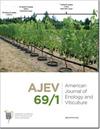西拉和赤霞珠葡萄酒的感官评价:收获成熟度和可溶性固形物优先化的影响
IF 1.8
3区 农林科学
Q3 BIOTECHNOLOGY & APPLIED MICROBIOLOGY
引用次数: 2
摘要
调整预发酵的可溶性固体必须是酿酒师操纵葡萄酒风味的工具。总可溶性固形物(TSS)通常在发酵前通过干裂或加水进行改性,但也可以在葡萄园中通过使果实在葡萄藤上进一步成熟来进行改性。本工作介绍了收获成熟度和预发酵TSS对赤霞珠(CS)和西拉(SY)葡萄酒风味的影响。每个品种的果实在三个大致成熟的目标下收获:20白利糖度(未成熟)、24白利糖率(成熟)和28白利糖(过熟)。首先对每次收获的Must进行划分,然后调整TSS以匹配每个目标到期日;例如将24 Brix收获的部分调节至20或28 Brix。描述性分析发现,CS葡萄酒中有10个属性差异显著,SY葡萄酒中有14个属性差异明显。收获成熟度主要影响CS的香气,因为用未成熟水果生产的葡萄酒表现出更高的绿色香气,但用成熟/过熟水果生产的酒表现出更大的果酱浆果香气。增加CS的预发酵TSS一定会增加苦味、热度和粘度的强度,但会降低酸味。预发酵TSS的增加对SY葡萄酒的风味产生了很大影响,其表现出更大的涩味、乙醇香气、热口感、果酱果香气、玫瑰香气、溶剂香气、乙醇香气和粘稠口感。SY果实成熟度显著影响果实的涩味和泥土香气,但硫、卷心菜香气和苦味在收获成熟度和TSS之间存在交互作用。本文章由计算机程序翻译,如有差异,请以英文原文为准。
Sensory Evaluation of Syrah and Cabernet Sauvignon Wines: Effects of Harvest Maturity and Prefermentation Soluble Solids
Adjusting the soluble solids of the prefermentation must is a tool by which winemakers can manipulate the flavor profile of a wine. Total soluble solids (TSS) are often modified prior to fermentation by chaptalization or the addition of water, but can be modified also in the vineyard, by allowing the fruit to further mature on the vine. This work presents the effects of harvest maturity and prefermentation TSS on the flavor profile of Cabernet Sauvignon (CS) and Syrah (SY) wines. Fruit from each cultivar was harvested at three approximate maturity targets: 20 Brix (unripe), 24 Brix (ripe), and 28 Brix (overripe). Must from each harvest was first divided, then the TSS was adjusted to match each of the target maturities; for example, portions of the 24 Brix harvest were adjusted to 20 or 28 Brix. Descriptive analysis found 10 attributes that varied significantly among the CS wines and 14 attributes which varied significantly among the SY wines. Harvest maturity primarily impacted the CS aroma profile, as wines produced from unripe fruit showed increased green aroma, but wines produced from ripe/overripe fruit showed increased jammy berries aroma. Increasing the prefermentation TSS of the CS must increased the intensity of bitterness, hotness, and viscosity, but decreased the sourness. The SY wine flavor profile was impacted heavily by increasing the prefermentation TSS, which showed greater intensities of astringency, ethanol aroma, hot mouthfeel, jammy fruit aroma, rose aroma, solvent aroma, ethanol aroma, and viscous mouthfeel. SY fruit maturity significantly affected astringency and earthy aroma, but an interactive effect between harvest maturity and TSS was found for sulfur, cabbage aroma, and bitterness.
求助全文
通过发布文献求助,成功后即可免费获取论文全文。
去求助
来源期刊

American Journal of Enology and Viticulture
农林科学-生物工程与应用微生物
CiteScore
3.80
自引率
10.50%
发文量
27
审稿时长
12-24 weeks
期刊介绍:
The American Journal of Enology and Viticulture (AJEV), published quarterly, is an official journal of the American Society for Enology and Viticulture (ASEV) and is the premier journal in the English language dedicated to scientific research on winemaking and grapegrowing. AJEV publishes full-length research papers, literature reviews, research notes, and technical briefs on various aspects of enology and viticulture, including wine chemistry, sensory science, process engineering, wine quality assessments, microbiology, methods development, plant pathogenesis, diseases and pests of grape, rootstock and clonal evaluation, effect of field practices, and grape genetics and breeding. All papers are peer reviewed, and authorship of papers is not limited to members of ASEV. The science editor, along with the viticulture, enology, and associate editors, are drawn from academic and research institutions worldwide and guide the content of the Journal.
 求助内容:
求助内容: 应助结果提醒方式:
应助结果提醒方式:


